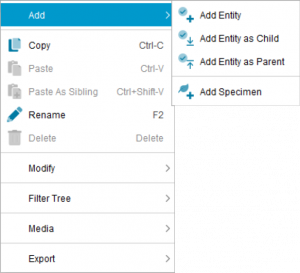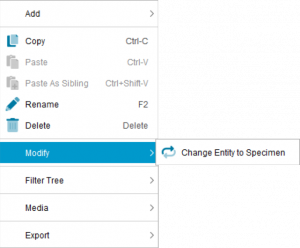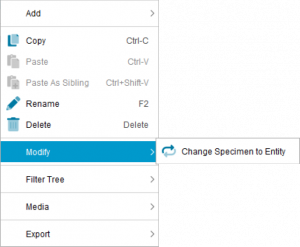Additional commands available via the context pop-up menu. The context menu can be accessed by right clicking on an item (or an empty section) within the Entities Tree panel.
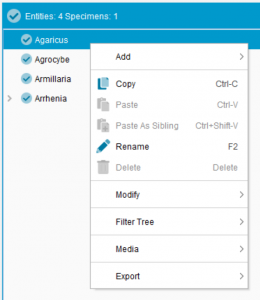
Add sub menu
 Add Entity
Add Entity
Adds a new Entity to the Entities tree. The Entity will be added at the same level within the tree based on where in the tree the context menu was initiated. The Add Entity option will only become available to select when it is logically appropriate. For example, the Builder will not allow an Entity to be created at the same or child level of a Specimen.
 Add Entity as Child
Add Entity as Child
Adds a new Entity as child of the selected Entity within the Entities tree. The Add Entity as Child option will only become available to select when it is logically appropriate. For example, the Builder will not allow an Entity to be created at the same or child level of a Specimen.
 Add Entity as Parent
Add Entity as Parent
Adds a new Entity as a parent of the selected Entity within the Entities tree. The Add Entity as Parent option will only become available to select when it is logically appropriate. For example, the Builder will not allow an Entity to be created as a parent if a Specimen was selected.
 Add Specimen
Add Specimen
Adds a new Specimen to an existing Entity within the Entities tree. See the help topic on Specimens for more information.
 Copy
Copy
Copies a selected Entity or Specimen to the system clipboard. A copy of the item may then be pasted elsewhere in the Entity tree.
If a copied item has children, all descendents will be copied along with the selected item. If an item has scores or other properties associated with it (media etc), all scores and properties will remain associated with the copied item and will be pasted with it.
 Paste
Paste
Pastes a previously cut or copied item as a child of the selected item.
If a cut or copied item has children, all descendents will be cut or copied and pasted along with the selected item. If an item has scores or other properties associated with it (media etc), all scores and properties will remain associated with the item and will be pasted with it.
 Paste as sibling
Paste as sibling
Pastes a previously cut or copied item as a sibling of the selected item.
If a cut or copied item has children, all descendents will be cut or copied and pasted along with the selected item. If an item has scores or other properties associated with it (media etc), all scores and properties will remain associated with the item and will be pasted with it.
 Rename
Rename
Renames a selected item in the Entities tree. The item will be placed into edit mode for renaming. Rename can also be invoked by pressing the F2 key.
 Delete
Delete
Deletes one or more selected Entities or Specimens.
If the Builder Preferences option Prompt for confirmation during tree delete operations is checked, a Confirm Delete dialog will appear to confirm that the operation should go ahead. If Prompt for confirmation during tree delete operations is unchecked, the item will be deleted immediately without confirmation.
The selected item will be permanently deleted from the key. This operation cannot be undone.
Modify sub menu
The Modify sub menu allows you to convert Entity types (Grouping Entity, Entity, Specimen). The menu option available is determined by the Entity type selected. For example, a single Entity can be converted to a specimen if it is the only child Entity. To convert all child Entities of a Grouping Entity, you must first select all child Entities, then initiate the context menu. All the selected child Entities will then be converted to Specimens. The same process applies for converting Specimens back to regular Entities.
 Change Entity to Specimen
Change Entity to Specimen
Converts one (or more) selected child Entities to Specimen Entities. All children of the Grouping Entity must be selected for conversion since a child Entity and Specimen Entity cannot be at the same level within the Entity tree.
 Change Specimen to Entity
Change Specimen to Entity
Converts one (or more) selected Specimen Entities to child Entities. All Specimens of the Parent Entity must be selected for conversion since Specimens and Entities cannot be at the same level within the Entity tree.
Filter Tree sub menu
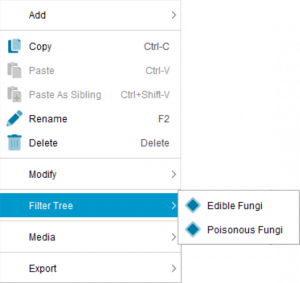
The options within the Filter Tree sub menu depend on what Entity Subsets have been created. All Entity Subsets will be listed as menu options. Each available Entity Subset can be toggled on or off by selecting or un-selecting the Subset within the menu. When an Entity Subset is toggled on, the Entities scored for that Subset will be displayed, while non-scored Entities for that Subset will be hidden. That is only Entities that are scored in the selected Subsets will be displayed.
Media sub menu
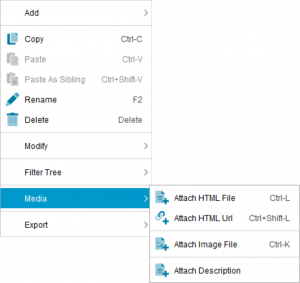
 Attach HTML File
Attach HTML File
Allows the attachment of a HTML (or PDF) file present within your keys Media folder to the selected Entity or Specimen.
 Attach HTML Url
Attach HTML Url
Allows the attachment of a Url based resource (E.g. web page) to the selected Entity or Specimen.
 Attach Image File
Attach Image File
Allows the attachment of an image(s) to the selected Entity or Specimen. Multiple image files can be attached via the file browse dialog by using Ctrl (individual selection) or the Shift key (block selection).
 Attach Description
Attach Description
Attaches a Description to the Entity. Descriptions cannot be attached to a specimen. For the Description to contain a description about the Entity you must create and/or attach a Description template (output template) for the key and associate this and the transform template (e.g. Sentence, paragraph or table etc) via the Key Options…Descriptions tab. See Creating Natural Language Descriptions help topic for more information.
Export sub menu

 Export Media
Export Media
Creates a Media List file containing references to all media associated with the selected Entity or Specimen. The Media List file will be automatically saved to the same location as the key (I.e. Where the .lk5 file is located). The file name is automatically generated based on the tree path to the Entity or Specimen and will include the selected items label.
See Media File help topic for more information.
 Export Scores
Export Scores
Creates a LIF3 file containing all the score information associated with the selected Entity or Specimen for all Features scored. The Export Scores function can be initiated from the Feature or a State of the Feature. The LIF3 file will be automatically saved to the same location as the key (I.e. Where the .lk5 file is located). The file name is automatically generated based on the tree path to the Feature or State and will include the selected items label.
See the LIF3 help topic for more information.


